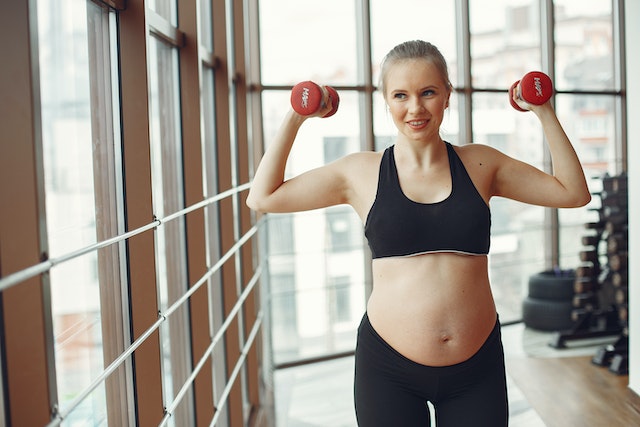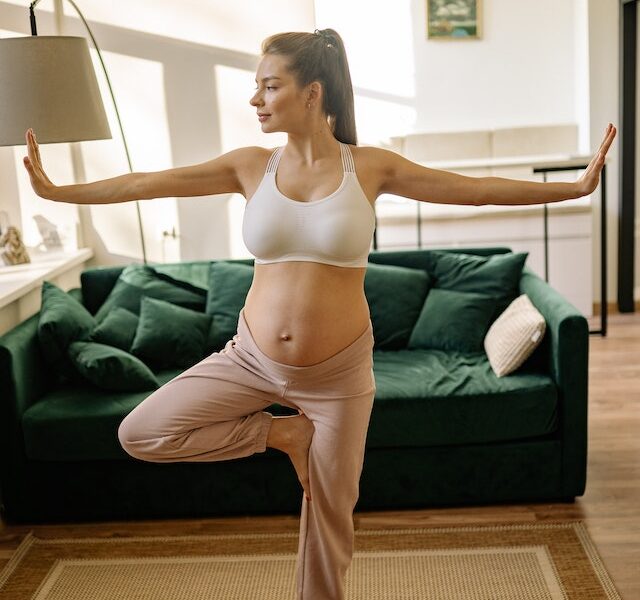Table of Contents
Overview
Exercise is essential during all stages of pregnancy including in 9th month. It is generally recommended by medical professionals unless there is any complications.
Pregnant women often fear exercising, particularly in the third trimester, due to premature birth or fetal harm concerns.
Research indicates that exercise can improve delivery outcomes by reducing complications and discomfort.
Physical exercise during the ninth month of pregnancy is very beneficial with modifications in style and body positioning to accommodate the changes in physical structure and the fetus’s requirements.
Pregnancy exercise can enhance health, reduce excessive weight gain, and potentially easy delivery.
Pregnant women can experience improved mental and physical health through exercise, which may promote better health outcomes for their newborns. However, very few around 40% pregnant women engage in physical activity.
Postnatal care for the mother : 11 tips to take care for yourself
According to a doctors, it is recommended to engage in moderate-intensity aerobic physical activity for a week, both during and after pregnancy.
A small exercise session is sufficient. Women can engage in physical activity either by exercising for 30 minutes five times a week or by exercising for 15 minutes ten times a week.
Women who engage in high-intensity exercises, such as running, before pregnancy can typically maintain their pre-existing routine but should consult with their physician before starting.
16 Exercises for 9 month of pregnancy with images
These low-risk activities provide full-body benefits and are generally safe to continue until delivery.
1. Swimming
Cardio exercises like swimming, water walking, and aqua aerobics offer joint-friendly movement. This can alleviate the additional body weight during the progression of pregnancy.

Selecting a comfortable stroke that does not cause strain or discomfort to the neck, shoulders, or back muscles is crucial. Breaststroke is a suitable option. A kickboard can also be effectively and can enhance the strength of the leg and buttock muscles.
Here are some of the Safety guidelines.
- Utilize the railing for stability during water entry to prevent slippage.
- Avoid activities such as diving or jumping that may cause abdominal impact.
- To reduce the risk of overheating, avoiding using warm pools, steam rooms, hot tubs, and saunas is advisable.
2. Cycling
Stationary cycling, commonly known as spinning, is a safe activity. This is widely trusted exercise by pregnant women in 9th month, including those exercising for the first time.
Some of the Advantages includes:
- Cycling is a low-impact exercise that elevates heart rate without exerting excessive pressure on the joints and pelvis.
- The bicycle aids in bearing the weight of the body.
- The stationary bike poses a low risk of falling.
- A higher handlebar may provide greater comfort during the later stages of pregnancy.
3. Low-impact Aerobics
Low-impact aerobic exercises are also good to include in 9th month of pregnancy. This involves maintaining at least one foot in contact with the ground.
This exercise modality has the potential to:
- Enhance cardiovascular endurance.
- Assist in preserving muscular tone and equilibrium.
- Minimize joint stress.
Prenatal classes are special classes to meet the specific needs of pregnant women. Prenatal classes offer the opportunity to socialize and receive specialized instruction from a qualified prenatal instructor.

Pregnant women who participate in regular aerobics classes should inform their instructor. The instructor can modify exercises and guide appropriate movements.
4. Squatting and Pelvic Tilts
Squatting can help to reduce delivery pain by facilitating the contraction and relaxation of the pelvic muscles. Assume a seated position by flexing your knees and utilizing a stability ball if desired. This reduces pressure in the thighs and pelvic region, thereby promoting relaxation.
Hospital bag checklist for dad: 19 essential things to check for
Specific exercises are beneficial during pregnancy as they aid in preparing the body for labor and delivery. Squatting during pregnancy may facilitate pelvic opening during labor. Therefore, it is good to incorporate squatting into prenatal exercises.
- Maintain a straight back and stand with your feet flat on the ground, positioned at shoulder width.
- Perform a controlled descent of the buttocks while maintaining flat feet and avoiding knee extension beyond the feet.
- Maintain a 10 to 30-second hold at the nadir, followed by a gradual ascent.
- Pelvic tilts can enhance abdominal muscle strength and alleviate back pain.
- Assume a quadrupedal position.
- The anterior tilt the pelvis and contract the abdominal muscles, causing a rounding of the spine.
- Please wait momentarily.
- This statement needs more clarity and context. Please provide more information or clarify the intended meaning.
- Perform this action for a maximum of 10 iterations.
5. Yoga
Prenatal yoga classes facilitate joint mobility and flexibility maintenance in women. It is well-proven that yoga can aid in managing pain and stress.
Yoga offers various advantages.

- Muscle strengthening.
- Enhancing blood flow.
- Assisting in the maintenance of healthy blood pressure.
- Enhancing flexibility.
- Facilitating relaxation.
- Teaching techniques for promoting calmness in women during labor and delivery.
During 9 month of pregnancy, you should avoid certain exercise and poses as the pregnancy progresses for safety reasons. Because
When to go to the hospital for labor: signs that labor has begun
- This may result in overbalance.
- The prone position entails lying on the abdomen.
- Entails supine positioning.
- The prone position can compress significant veins and arteries, reducing cardiac blood flow due to the bump’s weight. Reduced blood flow may cause syncope.
- Women should avoid overstretching to prevent injury.
6. Walking
Walk is the minimum and less stressful physical activity during pregnancy when other options are not feasible. This can effectively reduces weight gain and increases flexibility, whether done in one’s home, on the lawn, or in a park.
It can alleviate a variety of health issues, including constipation and restlessness. Engaging in a minimum of four 30-minute walking sessions per week is recommended, regardless of pace.
A brief walk around the local area is an appropriate starting point for individuals with low pre-pregnancy exercise levels.

This activity offers multiple benefits.
- This exercise regimen offers a low-impact cardiovascular workout that minimizes knee and ankle stress.
- Women’s work from home is cost-free.
- Pregnant women can walk at their discretion, without significant limitations on location or timing.
- Friends and other relatives can provide companionship.
To ensure safety while walking, it is recommended to opt for even surfaces, utilize appropriate footwear for stability, and steer clear of obstructions such as potholes and rocks.
7. Kegel Exercises
Kegel exercises, or pelvic floor exercises, are crucial for alleviating tension in the vaginal muscles that can occur during pregnancy. To perform this exercise, engage your pelvic floor muscle. Apply pressure for 10 seconds before releasing. This exercise can be performed 15-20 times throughout the day.

9. Cobbler Pose(Butterfly pose)

The butterfly pose is significant for improving the flexibility of the pelvic region. To perform this pose safely, it is recommended to use a cushion to support the back and thighs, which helps to maintain the center of gravity.
10. Downward Dog
Assume a feline stance by extending the fingers to their maximum width, flexing the toes inward, and applying pressure to the ground with the palms of the hands.
Steps to do it

- Assume the A-shaped position by bending forward and placing your palms and fingers on the floor, with your feet supporting your body weight.
- Flex and extend the right knee.
- Please repeat the same procedure for the left knee.
- Perform the procedure above iteratively for 10-15 cycles.
- Late pregnancy is not a suitable time for this exercise.
10. Opening Buttocks

This exercise involves performing a deep squat, which can be modified for pregnant individuals by sitting on their hips and spreading their legs to facilitate optimal energy release from the pelvis. Perform several deep breaths and then pause after repeating the process for approximately 3-5 cycles. This is a great exercise in 9th month for normal delivery.
11. Angry Cat
“Pelvic tilting” is another term for an angry cat, this can be done as prenatal exercise which can effectively alleviate labor pain during 9th month of pregnancy. It provides crucial support and fortification to the back muscles for childbirth.

How can you prepare for labor and childbirth: 20 tips to prepare yourself
It can align your hips with your stomach, providing increased lying flexibility until delivery. The exercise is commonly referred to as the “angry cat” due to the contraction of the abdominal muscles, which is similar to the behavior of animals displaying anger.
12. Side Lying Leg Lifts
Side-lying leg lifts are prenatal exercises that effectively target the hip abductor muscles, such as the gluteus Medius and minimums. Side-lying leg lifts offer advantages when included in a pregnancy exercise regimen during 9th month.

This effectively strengthen and tone the hip abductor muscles, which are crucial for maintaining stability and balance. Robust hip muscles can help in bearing the increasing weight of the fetus and relieve pressure on the lumbar spine and pelvic region.
here are the few advantages of this
Enhancing pelvic stability
Side-lying leg lifts improve pelvic stability by strengthening the pelvic muscles. Pelvic stability can aid the expanding uterus and mitigate unnecessary pain and discomfort
Improving Posture
Side-lying leg lifts activate the hip abductor muscles and facilitate appropriate pelvic alignment, potentially mitigating postural changes and enhancing posture.
13. Cat-Cow Stretch
The cat-cow stretch is a yoga exercise that involves transitioning between the cat pose (rounding the back) and the cow pose (arching the back). The cat-cow stretch provides various advantages when practiced during 9th month of pregnancy.
- Enhanced spinal flexibility and pain alleviation.
The baby’s growth can cause discomfort and strain in the back and spine due to increased weight and changes in posture.
Epidural during labor: Side effects of Epidural
The cat-cow stretch enhances spinal flexibility, alleviates back tension, and enhances spinal mobility. It facilitates stretching and relaxation of the back muscles, alleviating typical pregnancy-induced back pain.
- Optimizing fetal positioning.
The cat-cow stretch promotes optimal fetal positioning by facilitating correct alignment. Performing these poses can create pelvic space and promote optimal fetal positioning for childbirth, including the head-down position. This can enhance the efficiency of the labor and delivery process.
14. Deep Belly Breathing
Deep belly breathing, also referred to as diaphragmatic or abdominal breathing, entails intentionally inhaling slowly and deeply to expand the belly, as opposed to shallow chest breathing. Breathing during pregnancy offers various advantages.
- Stress reduction and relaxation.
Diaphragmatic breathing elicits a relaxation response and stimulates the parasympathetic nervous system. This promotes relaxation and counteracts the effects of stress.
- Enhanced oxygenation and circulation:
Deep abdominal breathing exercise enhances oxygen uptake, which is crucial for the well-being of both the mother and the developing fetus during 9th month. Slow and deep breathing improves the exchange of oxygen and carbon dioxide in the lungs, thereby augmenting the oxygen supply to the bloodstream.
15. Arm Exercises
Pregnant women can get various advantages by performing arm exercises in 9 month of pregnancy. Here are few benefits:

- Enhanced upper body muscular strength.
- Improved functionality and durability.
16. Prenatal Pilates
Prenatal Pilates is a modified version of Pilates exercise that caters to the unique needs of pregnant women in 9th month. The program emphasizes low-impact exercises that enhance core strength, flexibility, and physical wellness. Prenatal Pilates offers several advantages for pregnant women.

- Core stability is essential for optimal physical performance and injury prevention.
- Enhanced alignment and posture of the body.
FAQs on pregnancy exercise during 9th month
1. Which month to start exercise during pregnancy for normal delivery?
During the third trimester of pregnancy (weeks 28 to 40), it is permissible to continue exercising, provided the individual feels well and comfortable. Assuming no complications, it is generally safe to maintain physical activity throughout pregnancy until delivery. Continue engaging in low-impact exercises like walking and swimming. Gentle stretching can alleviate discomfort.
Are you worried about labor? 9 Signs of labor nearing or coming soon!
2. How much walk is required in the 9th month of pregnancy?
Is walking a safe activity during pregnancy? CDC advises that healthy pregnant or postpartum individuals should strive to engage in 150 minutes of exercise per week. The recommended exercise regimen consists of five 30-minute sessions of moderate-intensity activities, such as brisk walking.
3. Which week of pregnancy is the most tiring?
Fatigue is experienced during pregnancy, particularly in the initial 12 weeks. Hormonal fluctuations during this period may induce fatigue, nausea, and emotional instability. The optimal solution is to prioritize rest to the greatest extent feasible.





